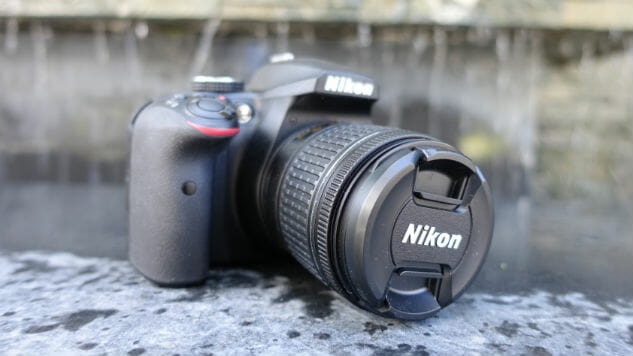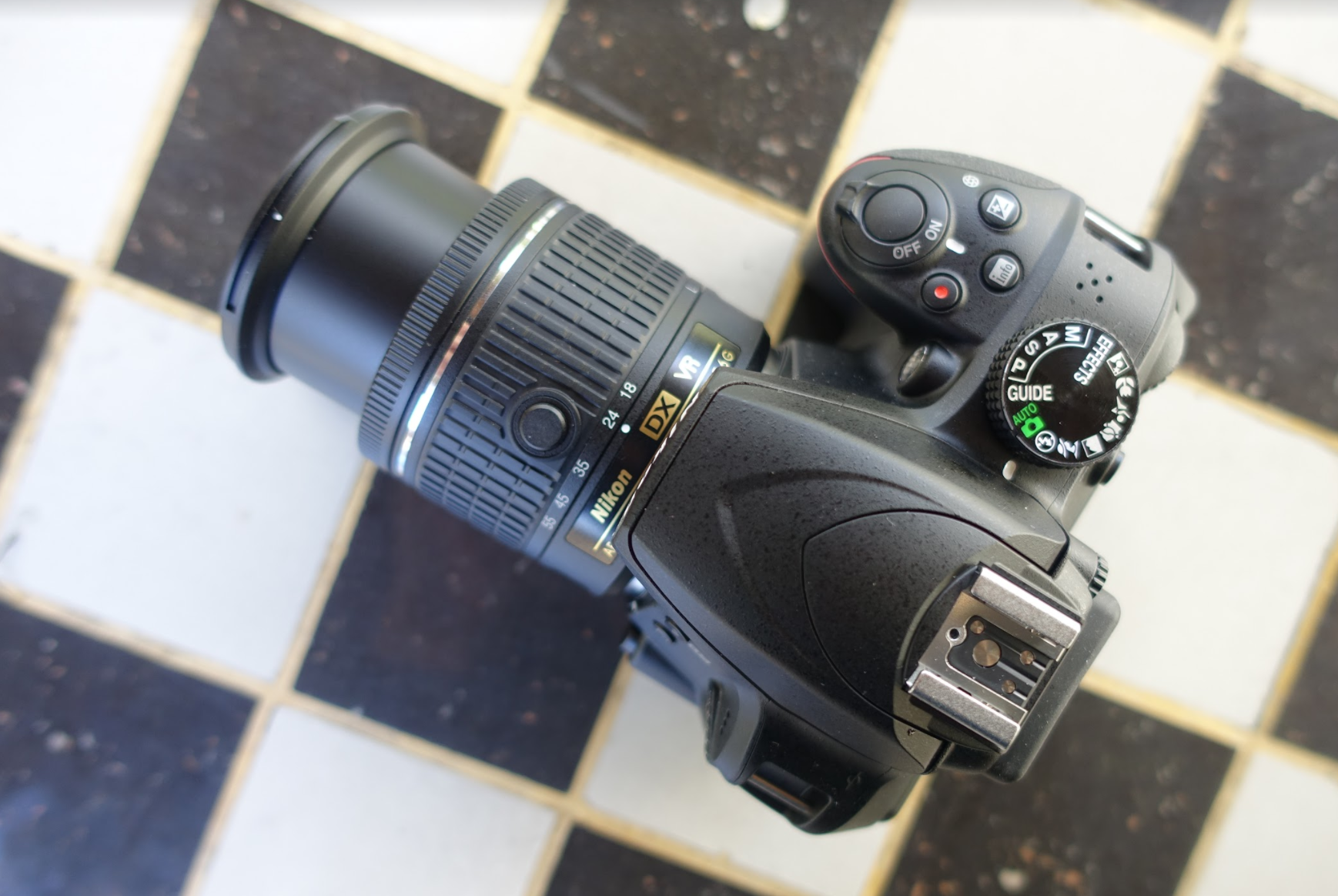
The D3400 is Nikon’s newest entry-level camera system, and it comes with plenty of features to entice beginning photographers. If you’re looking for more creative control and a more capable camera than your smartphone, the Nikon D3400 has plenty to offer. Despite its compact frame (for an APS-C format shooter) the camera comes with a rather chunky handgrip, which offered ergonomic controls and was a pleasure to use during longer photoshoots.
While the camera initially launched at $649 with an 18-55mm kit lens, prices have since dropped to as low as $419, making it an affordable and attractive choice to get started with photography. At its price point, the Nikon DSLR competes against more inexpensive mirrorless cameras on the market. Like DSLRs, Sony’s a5100, for example, offer photographers the ability to change lenses on the go, and boasts plenty of creative controls.
And if you’re coming from a smartphone, the D3400 will make you feel right at home with the ability to instantly share what you just captured with social media. Instead of relying on WiFi to transfer images from the camera to your phone like more expensive cameras, the Nikon D3400 opts to use Bluetooth LE for image transfers over the company’s SnapBridge app.
While Bluetooth may feel slower for transferring large 24-megapixel images, the upside is that the connection can be kept on with minimal drain to your battery. This means that SnapBridge will also be able to use GPS data from your phone to attach geolocation data to images captured with the D3400.
The result is that smartphone photographers moving to the D3400 will be able to instantly share their memories and save location information to their captured photos.
Design and Handling

The D3400 is a modest upgrade from its predecessors and shares the same basic design as the prior generation D3300. In fact, Nikon has used roughly the same black-clad DSLR design for its entry-level range since the D3100, but that’s not necessarily a bad thing.
Constructed mostly of plastic, save for the rubber grip and thumb grip, the D3400 weighs just under a pound with the battery and memory card inserted. At 14 ounces for the body, the light weight makes the D3400 feel less substantial—and a bit hollow—than more professional options. And while the lighter body makes the D3400 seem less premium, the upside—and it’s a big one—is that you won’t feel weighed down when you’re carrying the camera out with you all day.
The body measures 4.9 × 3.9 × 3.0 inches, making it fairly compact for a DSLR, even though the robust handgrip may make the D3400 seem bulkier than competing mirrorless cameras, like those from Fujifilm, Olympus, Panasonic and Sony. I appreciated the handgrip—controls are intuitively laid out within reaching distance of my thumb, and the grip makes the camera comfortable to hold and use over longer durations. I didn’t get the same sort of fatigue when holding the camera, especially with larger lenses, that I do when shooting with my Olympus PEN.
On the top, the controls are laid out on the right hand side. You have a large mode dial, which gives you access to your P, A, S, M shooting modes along with some effects and other creative modes. The Effects mode allows you to choose from ten different filters, and a few of the effects could even be applied after a photo is already captured. If you’re using the Effects mode to shoot, the camera takes over all controls, so if you want to retain creative control, shoot using one of the PASM modes and apply the effects in post-processing in camera.

The camera offers a variety of in-body post processing features, including red-eye correction, distortion correction, conversion to monochrome and image cropping. If you need more advanced edits, you can transfer images to your smartphone via the SnapBridge app or move the photos to your computer.
On top of the large grip, you’ll find a shutter button that’s integrated into the power switch, a dedicated video record button, an info button and a button to pull up your exposure compensation controls. The info button lets you cycle through different display modes to view guidelines and how much of your exposure settings you want to see on the camera’s 3-inch rear LCD display.
There’s also a LV button on the back, which gives you a live view. By default, Nikon sets the viewfinder for framing and the large LCD on the rear is primarily used to show exposure settings, but pressing the LV button to bring up live view is simple enough.
The LCD showed good details in live view mode with its 921,000-dot resolution, but I wish Nikon had included an articulating or tiltable screen with the camera. Aside from cost, it’s curious as to why Nikon didn’t equip the D3400 with a rotating screen given the camera hopes to appeal to selfie-obsessed smartphone users. For landscape and street shooters, the fixed screen proved problematic under bright light, attracting glare and reflections. And even though the LCD screen comes with a high resolution, another problem is that the display is of the non-touch variety, so you can’t touch on the image to quickly select your focus point in live view mode.

In video mode, the D3400 can shoot full HD videos at a maximum of 60p. Videographers can control exposure as well, and aperture and shutter speed can be changed during filming. The bundled NIKKOR lens offers smooth controls to change focusing and focal range, making it easy for video. If you’re moving around, you can also hit the AE button to lock exposure, as there is no peaking to warn you of blown out highlights when panning between light and dark scenes.
Unless you’re shooting sports videos or videos of fast moving children, subject tracking with video autofocus works decently well on the D3400 if you’re not a big manual focus person. When the focus changes, you’ll hear a faint sound of the motor in the lens. Fortunately, the motor sound is relatively quiet and isn’t distracting. Unfortunately, however, Nikon didn’t equip the D3400 with a microphone port—an external microphone would help mitigate some of the lens motor noise.
As a DSLR, the D3400 has a through-the-lens viewfinder that offers 0.85x magnification. If you wear glasses, a diopter ring to the top right of the optical viewfinder allows you to make adjustments. The eleven autofocus points are permanently etched into the viewfinder, and they light up with a half-press of the shutter button to indicate where the camera is focusing. The AF system does a good job at relatively fast speeds, but you may find more sophisticated autofocus implementations from competing mirrorless systems in this price point. For beginners, it may not make too big of a difference, however.

I found that autofocus speeds through the viewfinder is more responsive than looking at the larger LCD screen with live view. The camera is capable of Auto Area, Dynamic Area and 3D Tracking autofocus. Autofocus only works with select AF lenses, but you can attach all F-mount Nikkor lenses and use manual focus.
The D3400 supports a variety of ports, all of which are covered. There is an A/V output port, mini HDMI and USB ports, but Nikon eliminated the connectors from the D3300 that allowed users to attach a cable release and GPS unit. Most of these functions can be performed instead using the SnapBridge app when a smartphone is connected to the camera over Bluetooth. SnapBridge, however, won’t give you remote control of the shutter, unfortunately.
The camera takes a single SD card, which also supports the SDXC standard. A separate compartment on the bottom of the camera houses a battery. Nikon rates the battery for up to 1,200 shots, which is quite generous. However, be aware that the battery will drain faster with heavy use of the built-in popup flash.
And while not a small pancake lens by any stretch of the imagination, the kit lens folds up to a relatively small size when not in use. Following the trend to make kit lenses smaller, Nikon’s bundled Nikkor lens has a button on the side. When stowed, you’ll want to turn the lens to the L notch to lock it. To use the lens, flick the switch on the camera to on, and then push the button on the lens while turning the barrel to the appropriate focal length.
Image quality

Lacking an anti-aliasing filter over the sensor, images captured with the D3400 were sharp and clear. Out of camera JPEGs were vibrant with very minimal sharpening applied. I found that Canon cameras apply more aggressive sharpening, so the D3400 will give you a more natural-looking image. The 24-megapixel sensor does a terrific job capturing details and vibrant, punchy colors.
When paired with a more expensive prime lens, the D3400 performs impressively. There is a bit of corner softness with the kit lens. Dynamic range was terrific with the D3400, thanks in part to the larger APS-C sensor size, as compared to the smaller cameras found on today’s smartphones.
When shooting scenes with lighting that produces high contrast between the highlights and the shadows, Nikon’s Active D-Lighting feature for JPEGs works similar to HDR modes on smartphone cameras. When ADL is turned on, the D3400 will adjust the exposure to preserve details in the highlights, while at the same time increase luminance in the shadows. If you’re shooting RAW, you can recover details in the shadows in post as well.
If you’re shooting sports, the camera offers a burst shooting mode with 5 frames per second, with the D3400 slows down after 9 frames when shooting in RAW. Metering can be switched between multi, centre-weighted and spot, and the camera is able to handle exposure well, often erring on the side of underexposing a shot in high contrast environments.
In low light, the D3400 allows you to set the shutter to 30 seconds and there is also a bulb mode. Under Auto mode, the built-in flash tends to kick in. Surprisingly, even under bright sunlight, the D3400 often engaged the flash, which was a bit confusing.
If you don’t wish to use the flash, there is a no flash option on the mode dial. Under this mode, the camera will sometimes capture two images in reduced light and a single image with good light for processing. The vibration reduction VR lens does a good job of steadying the camera for handheld images captured in low light, working like OIS on smartphones.
Verdict

The Nikon D3400 offers excellent image quality for the beginning photographer, producing crisp results with vibrant colors. If you’re looking to step up your social media game, the D3400 lets you take your photos to the next level, offering the versatility of interchangeable lenses, more creative controls and sumptuous subject matter isolation that even the most clever of software can’t reproduce. The 24-megapixel sensor captures rich details, and with SnapBridge engaged, you’ll be able to add GPS tagging to your more professional quality images.
However, with a mode dial and single control dial, the D3400 feels more limited once you move out of your beginner stage. If you’re happy with the camera’s scene modes, effects, filters and automatic shooting modes, you’ll benefit from vastly improved image quality that a large sensor offers when compared to your smartphone’s shooter. But given the added bulk, it’d be nice to have a second dial for even more manual controls.
For most amateur shooters who don’t really care about learning manual modes or calculating exposure values, the D3400 is a delight to use and the images it produces are even more delightful. If you’re new to DSLR photography, at today’s reduced price, the D3400 packs a lot of value into its tiny little body, even if it only offers marginal improvements over its predecessor.